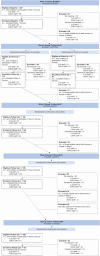Impact of learning health systems on cross-system collaboration between youth legal and community mental health systems: a type II hybrid effectiveness-implementation trial
- PMID: 39719625
- PMCID: PMC11667937
- DOI: 10.1186/s43058-024-00686-6
Impact of learning health systems on cross-system collaboration between youth legal and community mental health systems: a type II hybrid effectiveness-implementation trial
Abstract
Background: Youth involved in the legal system have disproportionately higher rates of problematic substance use than non-involved youth. Identifying and connecting legal-involved youth to substance use intervention is critical and relies on the connection between legal and behavioral health agencies, which may be facilitated by learning health systems (LHS). We analyzed the impact of an LHS intervention on youth legal and behavioral health personnel ratings of their cross-system collaboration. We also examined organizational climate toward evidence-based practice (EBP) over and above the LHS intervention.
Methods: Data were derived from a type II hybrid effectiveness trial implementing an LHS intervention with youth legal and community mental health centers (CMHCs) in eight Indiana counties. Using a stepped wedge design, counties were randomly assigned to one of three cohorts and stepped in at nine-month intervals. Counties were in the treatment phase for 18 months, after which they were in the maintenance phase. Youth legal system and CMHC personnel completed five waves of data collection (n=307 total respondents, ranging from 108-178 per wave). Cross-system collaboration was measured via the Cultural Exchange Inventory, organizational EBP climate via the Implementation Climate Scale and Implementation Citizenship Behavior Scale, and intervention via a dummy-coded indicator variable. We conducted linear mixed models to examine: 1) the treatment indicator, and 2) the treatment indicator and organizational EBP climate variables on cross-system collaboration.
Results: The treatment indicator was not significantly associated with cross-system collaboration. When including the organizational EBP climate variables, the treatment indicator significantly predicted cross-system collaboration. Compared to the control phase, treatment (B=0.41, standard error [SE]=0.20) and maintenance (B=0.60, SE=0.29) phases were associated with greater cross-system collaboration output.
Conclusions: The analysis may have been underpowered to detect an effect; third variables may have explained variance in cross-system collaboration, and, thus, the inclusion of important covariates may have reduced residual errors and increased the estimation precision. The LHS intervention may have affected cross-system collaboration perception and offers a promising avenue of research to determine how systems work together to improve legal-involved-youth substance use outcomes. Future research is needed to replicate results among a larger sample and examine youth-level outcomes.
Trial registration: Clinicaltrials.gov identifier: NCT04499079. Registered 30 July 2020. https://clinicaltrials.gov/study/NCT04499079 .
Keywords: Behavioral health; Community mental health; Cross-system collaboration; Juvenile justice; Learning health system; Legal system; Mental health; Type II hybrid effectiveness implementation trial; Youth.
© 2024. The Author(s).
Conflict of interest statement
Declarations. Ethics approval and consent to participate: ADAPT was approved by the first author’s Institutional Review Board (Protocol #1910282231). All participants were consented to participate. If individuals did not consent to participation, their data were excluded from analyses. Consent for publication: All authors consent for publication. Competing interests: Gregory Aarons, PhD, serves on the editorial board for Implementation Science Communications. All other authors declare no conflict of interest relevant to submission.
Figures
Similar articles
-
Alliances to disseminate addiction prevention and treatment (ADAPT): A statewide learning health system to reduce substance use among justice-involved youth in rural communities.J Subst Abuse Treat. 2021 Sep;128:108368. doi: 10.1016/j.jsat.2021.108368. Epub 2021 Mar 16. J Subst Abuse Treat. 2021. PMID: 33867210 Free PMC article.
-
Implementing risk stratification to the treatment of adolescent substance use among youth involved in the juvenile justice system: protocol of a hybrid type I trial.Addict Sci Clin Pract. 2019 Sep 6;14(1):36. doi: 10.1186/s13722-019-0161-5. Addict Sci Clin Pract. 2019. PMID: 31492186 Free PMC article.
-
Organizational structure, climate, and collaboration between juvenile justice and community mental health centers: implications for evidence-based practice implementation for adolescent substance use disorder treatment.BMC Health Serv Res. 2020 Oct 8;20(1):929. doi: 10.1186/s12913-020-05777-3. BMC Health Serv Res. 2020. PMID: 33032587 Free PMC article.
-
Impact of summer programmes on the outcomes of disadvantaged or 'at risk' young people: A systematic review.Campbell Syst Rev. 2024 Jun 13;20(2):e1406. doi: 10.1002/cl2.1406. eCollection 2024 Jun. Campbell Syst Rev. 2024. PMID: 38873396 Free PMC article. Review.
-
Public sector reforms and their impact on the level of corruption: A systematic review.Campbell Syst Rev. 2021 May 24;17(2):e1173. doi: 10.1002/cl2.1173. eCollection 2021 Jun. Campbell Syst Rev. 2021. PMID: 37131927 Free PMC article. Review.
References
-
- Schwalbe CS. Impact of probation interventions on drug use outcomes for youths under probation supervision. Child Youth Serv Rev. 2019;98:58–64.
-
- Prinz RJ, Kerns SE. Early substance use by juvenile offenders. Child Psychiatry Hum Dev. 2003;33:263–77. - PubMed
-
- Aarons GA, Brown SA, Hough RL, Garland AF, Wood PA. Prevalence of adolescent substance use disorders across five sectors of care. J Am Acad Child Adolesc Psychiatry. 2001;40(4):419–26. - PubMed
-
- Johnson TP, Cho YI, Fendrich M, Graf I, Kelly-Wilson L, Pickup L. Treatment need and utilization among youth entering the juvenile corrections system. J Subst Abuse Treat. 2004;26(2):117–28. - PubMed
Associated data
LinkOut - more resources
Full Text Sources
Medical



